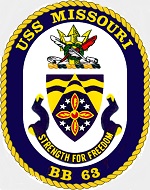Forces of Valor FOV861003A US Navy Iowa Class Battleship - USS Missouri (BB-63), Signing of the Japanese Surrender, Tokyo Bay, 1945 [Full Hull Version] (1:700 Scale)
"It is my earnest hope, and indeed the hope of all mankind, that from this solemn occasion a better world shall emerge out of the blood and carnage of the past -- a world dedicated to the dignity of man and the fulfillment of his most cherished wish for freedom, tolerance and justice."
- Gen. Douglas MacArthur, aboard the USS Missouri at the conclusion to the signing of the Instrument of Surrender, September 2nd, 1945
 USS Missouri (BB-63) ("Mighty Mo" or "Big Mo") is a United States Navy Iowa-class battleship, and was the fourth ship of the U.S. Navy to be named in honor of the U.S. state of Missouri. Missouri was the last battleship built by the United States, and was the site of the surrender of the Empire of Japan which ended World War II.
USS Missouri (BB-63) ("Mighty Mo" or "Big Mo") is a United States Navy Iowa-class battleship, and was the fourth ship of the U.S. Navy to be named in honor of the U.S. state of Missouri. Missouri was the last battleship built by the United States, and was the site of the surrender of the Empire of Japan which ended World War II.
Missouri was ordered in 1940 and commissioned in June 1944. In the Pacific Theater of World War II she fought in the battles of Iwo Jima and Okinawa and shelled the Japanese home islands, and she fought in the Korean War from 1950 to 1953. She was decommissioned in 1955 into the United States Navy reserve fleets (the "Mothball Fleet"), but reactivated and modernized in 1984 as part of the 600-ship Navy plan, and provided fire support during Operation Desert Storm in January/February 1991.
Missouri received a total of 11 battle stars for service in World War II, Korea, and the Persian Gulf, and was finally decommissioned on March 31st, 1992, but remained on the Naval Vessel Register until her name was struck in January 1995. In 1998, she was donated to the USS Missouri Memorial Association and became a museum ship at Pearl Harbor, Hawaii.
Pictured here is a 1:700 scale replica of the US Navy Iowa class battleship, USS Missouri (BB-63), when it witnessed the Signing of the Japanese Surrender in Tokyo Bay, during September 1945.
Sold Out!
Diorama Dimensions:
Length: 15-inches
Release Date: November 2017
 Historical Account: "Museum Ship" - Missouri remained part of the reserve fleet at Puget Sound Naval Shipyard, Bremerton, Washington, until January 12th, 1995, when she was struck from the Naval Vessel Register. On May 4th, 1998, Secretary of the Navy John H. Dalton signed the donation contract that transferred her to the nonprofit USS Missouri Memorial Association (MMA) of Honolulu, Hawaii. She was towed from Bremerton on May 23rd to Astoria, Oregon, where she sat in fresh water at the mouth of the Columbia River to kill and drop the saltwater barnacles and sea grasses that had grown on her hull in Bremerton, then towed across the eastern Pacific, and docked at Ford Island, Pearl Harbor on June 22nd, just 500 yd (460 m) from the Arizona Memorial. Less than a year later, on January 29th, 1999, Missouri was opened as a museum operated by the MMA.
Historical Account: "Museum Ship" - Missouri remained part of the reserve fleet at Puget Sound Naval Shipyard, Bremerton, Washington, until January 12th, 1995, when she was struck from the Naval Vessel Register. On May 4th, 1998, Secretary of the Navy John H. Dalton signed the donation contract that transferred her to the nonprofit USS Missouri Memorial Association (MMA) of Honolulu, Hawaii. She was towed from Bremerton on May 23rd to Astoria, Oregon, where she sat in fresh water at the mouth of the Columbia River to kill and drop the saltwater barnacles and sea grasses that had grown on her hull in Bremerton, then towed across the eastern Pacific, and docked at Ford Island, Pearl Harbor on June 22nd, just 500 yd (460 m) from the Arizona Memorial. Less than a year later, on January 29th, 1999, Missouri was opened as a museum operated by the MMA.
Originally, the decision to move Missouri to Pearl Harbor was met with some resistance. Many people feared that the battleship, whose name has become synonymous with the end of World War II, would overshadow the battleship Arizona, whose dramatic explosion and subsequent sinking on December 7th, 1941, has since become synonymous with the attack on Pearl Harbor. To help guard against this perception Missouri was placed well back from and facing the Arizona Memorial, so that those participating in military ceremonies on Missouri's aft decks would not have sight of the Arizona Memorial. The decision to have Missouri's bow face the Arizona Memorial was intended to convey that Missouri now watches over the remains of Arizona so that those interred within Arizona's hull may rest in peace.
Missouri is not eligible for designation as a National Historic Landmark although she was listed on the National Register of Historic Places on May 14th, 1971, for hosting the signing of the instrument of Japanese surrender that ended World War II. This is because she was extensively modernized in the years following the surrender.
On October 14th, 2009, Missouri was moved from its berthing station on Battleship Row to a drydock at the Pearl Harbor Naval Shipyard, where the warship would undergo a three month overhaul. The work included installing a new anti-corrosion system, repainting the hull, and upgrading the internal mechanisms. Drydock workers reported that the ship was leaking at some points on the starboard side.





 Good Service
Good Service 



 Battleship
Battleship